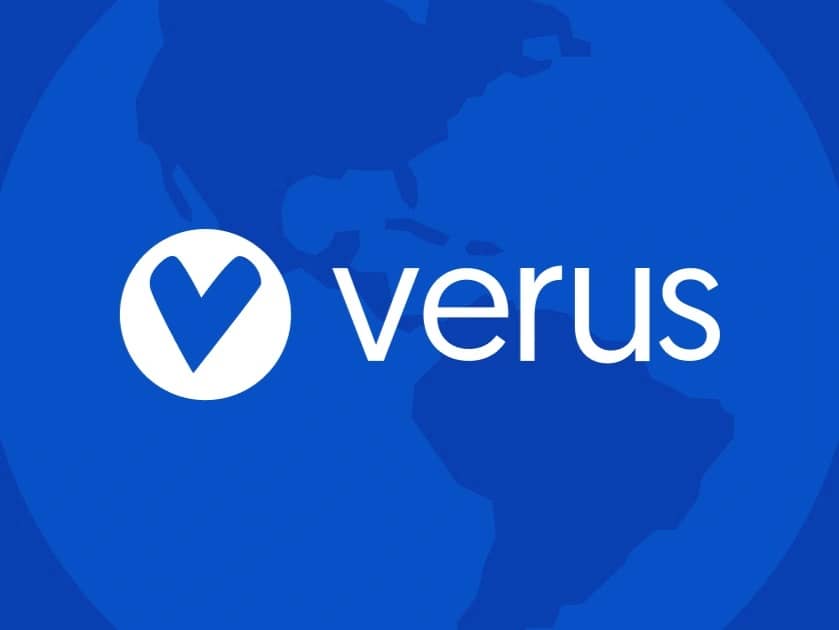위키 구독하기
Share wiki
Bookmark
Verus
Verus
Verus(베루스)는 탈중앙화된 오픈소스 블록체인 프로토콜로, 작업증명(Proof-of-Work)과 지분증명(Proof-of-Stake) 합의 메커니즘을 사용합니다. 제품, 서비스 및 시스템 개발을 위한 무료 도구를 제공하는 것을 목표로 하며, 프로토콜 기본 기능을 통해 자기 주권 신원, 다중 통화 DeFi, 그리고 체인 간 기능을 가능하게 하여 스마트 계약에 대한 의존성을 제거합니다.[1]
개요
2018년에 공정하게 출시된 Verus는 오픈소스 기반의 탈중앙화된 블록체인 프로토콜로, "작업증명"(Proof-of-Power)이라고 불리는 작업증명(Proof-of-Work)과 지분증명(Proof-of-Stake)의 조합을 사용합니다. 서비스형 공용 블록체인(PBaaS)을 제공하여 상호 운용 가능한 블록체인, 토큰 및 탈중앙화 금융(DeFi) 애플리케이션을 만드는 것을 통해 확장성, 보안 및 탈중앙화를 우선시하는 것을 목표로 합니다.
이 프로토콜은 자기 주권 디지털 신원을 위한 VerusID를 통합하고 최소 수수료로 안전한 크로스체인 거래를 지원합니다. Verus는 탈중앙화되고 확장 가능하며 사용자 정의가 가능한 블록체인 사용 사례를 가능하게 하도록 다중 체인 생태계로 설계되었습니다. [1] [2] [3] [4]

제품
PBaaS 체인
Verus는 확장성, 상호 운용성 및 접근성을 우선시하는 블록체인 솔루션을 제공하는 것을 목표로 합니다. 서비스형 공용 블록체인(PBaaS) 프레임워크를 통해 다중 통화 기능, 탈중앙화 금융(DeFi), 자기 주권 신원(VerusID) 및 zk-SNARK 기반 개인 정보 보호와 같은 기능을 갖춘 사용자 정의 가능한 블록체인을 만들 수 있습니다.
이러한 블록체인은 Verus 네트워크와 통합되어 크로스체인 거래를 지원하고 하이브리드 작업증명(Proof-of-Work) 및 지분증명(Proof-of-Stake) 합의를 사용하여 51% 해시 공격에 대한 저항력을 갖도록 설계되었습니다. Verus는 참여 및 환불을 관리하는 메커니즘을 통해 토큰 생성, 유동성 풀, 분수 준비금 통화 및 크라우드 펀딩 출시를 지원합니다. 다중 체인 생태계는 상호 운용 가능한 공용 및 개인 블록체인을 지원하도록 구성되어 원활한 연결 및 탈중앙화된 브리징을 보장하는 것을 목표로 합니다. [5]
통화 출시
Verus는 코딩 없이 토큰을 생성할 수 있도록 합니다. 여러 준비금으로 뒷받침되는 바스켓 통화와 고정 또는 조정 가능한 공급량을 가진 단순 토큰 통화를 지원합니다. Verus-이더리움 브리지는 이더리움과의 비보관 전송을 가능하게 합니다. 탈중앙화된 크라우드 펀딩 메커니즘은 참여 수준을 설정하고, 환불을 제공하고, 출시 전 할인을 제공하여 토큰 출시를 지원하는 것을 목표로 합니다. [6]
VerusID
VerusID는 Verus Protocol 블록체인의 탈중앙화된 자기 주권 신원 시스템입니다. 사용자가 프로그래밍 기술 없이 Web3 애플리케이션에 액세스하고, 자산을 관리하고, 개인 메시지를 보내고, 데이터를 안전하게 저장할 수 있도록 합니다. VerusID는 개인 또는 비즈니스 식별자로서 거래, 안전한 통신 및 자산 관리를 지원합니다. 기능에는 비보관 취소/복구, 멀티시그 지갑 및 개인 정보 보호 옵션이 포함됩니다.
VerusID는 100 VRSC로 이용 가능하며, 추천 할인이 적용됩니다. 수수료는 채굴자, 스테이커 및 지속적인 개발에 기여합니다.
최상위 VerusID는 100 VRSC로 이용 가능하며, 추천 할인이 적용됩니다. 이러한 ID만 블록체인 또는 통화 생성에 사용할 수 있습니다. 다른 모든 용도에는 하위 ID를 사용할 수 있으며, 최소 비용은 0.02 $VRSC입니다. 이러한 수수료는 채굴자와 스테이커에게 배분됩니다. [7] [12]
VerusPay
VerusPay는 블록체인 기반 청구서 생성 및 지불 처리를 용이하게 하는 것을 목표로 합니다. v3 버전은 표준화된 청구서 형식을 도입하고, PBaaS 블록체인 거래를 지원하며, QR 코드 또는 딥링크를 통해 공유할 수 있도록 합니다. [8]
VerusDeFi
VerusDeFi는 중개자 없이 저렴하고 MEV에 대한 저항력이 있는 탈중앙화 금융 솔루션을 제공하는 것을 목표로 합니다. 사용자가 준비금 기반 통화로 전환하거나 준비금 간에 교환할 수 있으며, 수수료는 0.025%~0.05%입니다.
작업은 합의 계층에서 실행되어 스마트 계약 위험을 줄입니다. VerusDeFi는 DeFi 기능을 프로토콜에 직접 통합하여 스마트 트랜잭션을 사용하여 보안을 강화합니다. [9]
잘못된 내용이 있나요?
